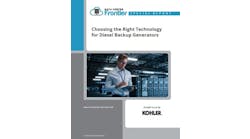Podcast: Quantum Corridor CEO Tom Dakich On U.S. Midwest Data Center Horizons
For this episode of the DCF Show podcast, Data Center Frontier Editor in Chief Matt Vincent and Senior Editor David Chernicoff speak with Tom Dakich, CEO of Quantum Corridor.
Background
Almost exactly a year ago, Quantum Corridor launched what the company bills as "one of the fastest, most secure fiber-optic networks in the Western Hemisphere" with its first transmissions from the Chicago ORD 10 Data Center at 350 E. Cermak Rd. to a data center in Hammond, Indiana.
Formed in 2021 as a public-private partnership with the state of Indiana, Quantum Corridor was established to enable advanced Illinois and Indiana tech innovators to exchange data nearly instantaneously, the better to achieve frontline technology breakthroughs.
Funded through a $4.0 million grant from the state of Indiana’s READI grant program and with the cooperation of the Indiana Department of Transportation and Northwest Indiana Forum, Quantum Corridor's network is utilizing 263 miles of new and existing fiber-optic cable beneath the Indiana Toll Road to link data centers, quantum research facilities, life sciences and genome scientists and hyperscalers with industry-shattering speeds and throughput.
Transmitting at data speeds reportedly 1,000x faster than traditional networks, on its launch in 2023, Quantum Corridor said the new network aims to enable regional businesses and institutions to achieve breakthroughs in the segments for defense, financial modeling, biotech, cybersecurity, machine learning, research and more. This optimism came on the heels of the Biden-Harris administration’s designation last October of of the Chicago MSA as a U.S. Regional Technology and Innovation Hub.
With its first transmissions, Quantum Corridor achieved a latency of 0.266 milliseconds of information exchange over its current 12-mile network—a transmission speed 500 times faster than the blink of an eye and far exceeding the average network’s existing 12-times-longer latency.
The combination of near-instantaneous transmissions paired with massive throughput is expected to enable exponential breakthroughs in modeling and problem solving across myriad industries. Quantum Corridor continues to expand its mileage and connect research facilities. According to the company, the network already has the capacity to transmit nearly the entire current content load of the internet in a single transmission.
Quantum Commercialization Center
On the DCF podcast, Quantum Corridor's CEO Tom Dakich spoke about his being a former managing member of Hammond, Indiana data center operator Digital Crossroad, whose customers include hyperscalers and large enterprise users.
In addition to transforming the former coal-fired power plant at the border of Hammond and Chicago into the current data center featuring a smart greenhouse, upcycled materials and green power options, Dakich also helped spearhead the lobbying effort for Indiana’s data center tax incentive law, attracting such tech giants as Amazon and Google.
Meanwhile, as a Bloch Tech Hub member, Quantum Corridor recently partnered with The Roberts Impact Lab at Purdue University Northwest, a regional tech transfer and commercialization hub, to develop a quantum commercialization center and hub for quantum information science and technology (QIST).
Dakich also discussed Chicago also celebrated a recent ordinance to incentivize developers, helping to pave the way for smaller-scale data centers, like Digital Crossroad, and quantum centers to create new job opportunities and spur local economic growth in and around Chicagoland.
Here's a timeline of the interview's key moments:
6:04 - Quantum Corridor CEO Tom Dakich recounts the collaboration between local leaders and organizations in Indiana to build a data center industry, showcasing community effort and vision.
11:16 - Dakich explains the sustainable practices implemented at Digital Crossroad, including using lake water cooling and partnering with Indiana natural gas and electric utility NIPSCO for renewable energy.
16:20 - Dakich explains developments for a plan to integrate quantum computing with the activities of hyperscaler giants like IBM, Microsoft, and AWS, focusing on creating tech centers and even quantum commercialization centers that use advanced fiber technology and incorporate quantum elements. This plan aims to attract researchers, facilitating advanced research in quantum computing, while creating fertile ground for collaboration between data centers and researchers.
19:14 - Dakich shares insights on Indiana's legislation that has transformed the state into a leading market for data centers, highlighting the collaborative efforts involved.
22:38 - Dakich mentions companies such as PsiQuantum and NVIDIA working on quantum computing within his organization's scope, indicating a competitive race to advance this technology.
32:05 - Dakich addresses the completion of Quantum Corridor's phase one and mentions the network's starting point at 350 E. Cermak, ending at the Digital Crossroad data center in Hammond.
32:13 - Dakich talks about the deployment of Quantum Corridor's phase two, including expanding the network south through Indiana to the Crane Naval Base and connecting different sites within Chicago.
Recent DCF Show Podcast Episodes
- Phillip Koblence, COO and Co-Founder, NYI; Co-Founder, Nomad Futurist
- Data Center Construction and Dallas Market Talk with Burns & McDonnell
- Data Center Frontier's Rich Miller Talks Gigawatt MegaCampus Predictions
- ZutaCore Executives Recap NVIDIA GTC Data Center Liquid Cooling Playbook
- NVIDIA, Equinix, JetCool Talk Data Center Liquid Cooling, GTC 2024 AI Conference Trends
Did you like this episode? Be sure to subscribe to the Data Center Frontier show at Podbean to receive future episodes on your app.
Keep pace with the fast-moving world of data centers and cloud computing by connecting with Data Center Frontier on LinkedIn, following us on X/Twitter and Facebook, and signing up for our weekly newsletters using the form below.

Matt Vincent
A B2B technology journalist and editor with more than two decades of experience, Matt Vincent is Editor in Chief of Data Center Frontier.





